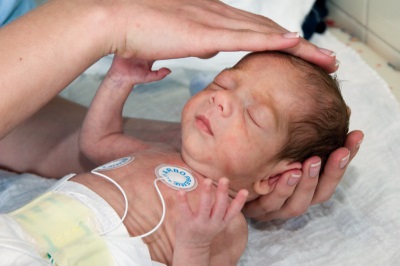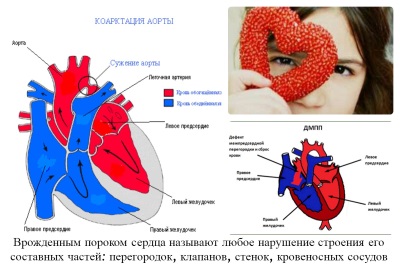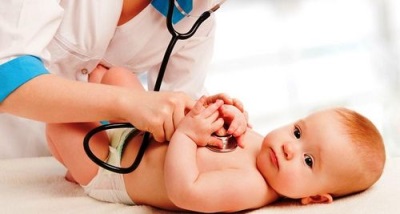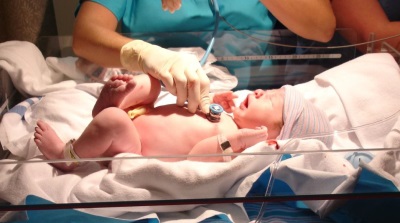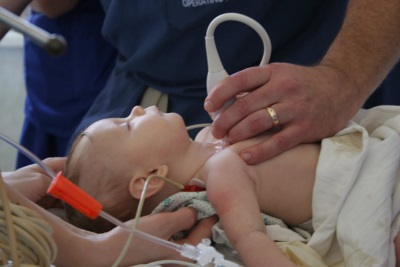Heart disease in newborns
During the development of an infant in the womb, sometimes the processes of growth and formation of tissues and organs are disturbed, leading to the appearance of defects. One of the most dangerous are heart defects.
What is a heart defect?
So called pathology in the structure of the heart and large vessels that depart from it. Heart defects interfere with normal blood circulation, are detected in one out of 100 newborns and, according to statistics, are in second place for congenital abnormalities.
Forms
First of all, there is a congenital defect with which the child is born, as well as acquired, arising from autoimmune processes, infections and other diseases. In childhood, congenital malformations are more common and are divided into:
- Pathologies in which blood is dumped to the right side. Such evils are called "white" because of the pallor of the child. When they are arterial blood enters the venous, often causing an increase in blood flow to the lungs and a decrease in blood volume in a large circle. The defects of this group are defects of the partitions separating the heart chambers (atria or ventricles), the arterial duct functioning after birth, coarctation of the aorta or narrowing of its bed, as well as pulmonary stenosis. At the last pathology, blood flow to the vessels of the lungs, on the contrary, decreases.
- Pathologies in which the discharge of blood occurs to the left. These defects are called "blue", because one of their symptoms is cyanosis. They are characterized by the entry of venous blood into the arterial blood, which reduces the saturation of blood with oxygen in the great circle. A small circle with such defects can both be depleted (with the triad or with Fallot's tetrad, as well as with Ebstein's anomaly), and enrich (with the wrong location of the pulmonary arteries or aorta, as well as with the Eisenheimer complex).
- Pathologies in which there is an obstruction to the blood flow. These include abnormalities of the aortic, tricuspid or mitral valve, in which the number of their valves changes, their insufficiency is formed, or valve stenosis occurs. Also to this group of defects include improper placement of the aortic arch. With such pathologies arterial-venous discharge is absent.
Symptoms and signs
Most babies have heart defects that have developed intrauterinely, manifest clinically even during the stay of the crumbs in the maternity hospital. Among the most common symptoms noted:
- Rapid pulse.
- Blue limbs and face in the area above the upper lip (it is called the nasolabial triangle).
- The paleness of the palms, nose and feet, which will also be cool to the touch.
- Bradycardia.
- Frequent regurgitation.
- Shortness of breath.
- Weak sucking breasts.
- Insufficient weight gain.
- Fainting
- Edema.
- Sweating
Why are children born with a heart defect?
The exact causes of these pathologies, doctors have not yet identified, but it is known that violations of the development of the heart and blood vessels provoke such factors:
- Genetic addiction.
- Chromosomal diseases.
- Chronic diseases in the future mother, for example, thyroid disease or diabetes.
- The future mother is over 35 years old.
- Taking medication during pregnancy that has a negative effect on the fetus.
- Unfavorable environmental situation.
- Stay pregnant in high radioactive background.
- Smoking in the first trimester.
- The use of drugs or alcohol in the first 12 weeks after conception.
- Poor obstetric history, for example, miscarriage or abortion in the past, premature previous childbirth.
- Viral diseases in the first months of pregnancy, especially rubella, herpes infection and influenza.
The period from the third to the eighth week of pregnancy is called the most dangerous period for the formation of heart defects. It was during this period that the chambers of the heart, its partitions, as well as the great vessels were laid in the fetus.
The following video tells in more detail about the causes that can lead to congenital heart disease.
Phases
For each child, the development of a heart defect goes through three phases:
- Stage of adaptation, when to compensate for the problem of the child's body mobilizes all reserves. If they are not enough, the child dies.
- Stage compensation, during which the child's body is relatively stable.
- The stage of decompensation, in which the reserves are exhausted, and the crumbs of heart failure.
Diagnostics
It is possible to suspect the development of congenital heart disease in a child during routine ultrasound examinations during pregnancy. Some pathologies become noticeable to the doctor-uzist since the 14th week of gestation. If obstetricians are aware of the vice, they develop a special tactic for the management of labor and decide with cardiac surgeons the question of a baby’s heart surgery in advance.
In some cases, ultrasound during pregnancy does not show heart disease, especially if it is associated with a small circle of blood circulation that does not function in the fetus. Then you can identify the pathology of the newborn after examining and listening to the heart of the baby. The doctor will be alerted by the pallor or cyanosis of the skin of the toddler, a change in the heart rate and other symptoms.
After listening to the baby, the pediatrician will detect noises, splitting tones or other disturbing changes. This is the reason to send the baby to a cardiologist and appoint him:
- Echocardioscopy, through which you can visualize the defect and establish its severity.
- ECG to detect cardiac arrhythmias.
Some babies for x-ray diagnosis spend x-ray, catheterization or CT.
Treatment
In most cases, for heart defects in a newborn, he requires surgical treatment. The operation for children with heart defects is performed depending on the clinical manifestations and the severity of the pathology. Some babies are shown immediate surgical treatment immediately after the discovery of the defect, while others perform an intervention during the second phase, when the body compensates for its strength and is easier to undergo surgery.
If decompensation occurs during a defect, surgical treatment is not indicated, since it will not be able to eliminate the irreversible changes that have appeared in the internal organs of the child.
All children with congenital malformations after the diagnosis is clarified are divided into 4 groups:
- Kids who do not need an urgent operation. Their treatment is delayed for several months or even years, and if the dynamics are positive, surgical treatment may not be required at all.
- Infants who should be operated on in the first 6 months of life.
- Baby, to operate in the first 14 days of life.
- Crumbs, which immediately after birth are sent to the operating table.
The operation itself can be performed in two ways:
- Endovascular. Small punctures are made to the child and, through large vessels, are picked up to the heart, controlling the whole process by means of x-rays or ultrasound. In case of defects of the partitions, the probe brings an occluder to them, closing the opening.With unclosed arterial duct, a special clip is installed on it. If the child has valve stenosis, balloon plastic surgery is performed.
- Open. The rib cage is cut, and the child is connected to artificial blood circulation.
Before surgical treatment and after it, children with a defect are prescribed medicines from different groups, for example, cardiotonics, blockers and antiarrhythmic drugs. With some defects, the child does not need surgery and drug therapy. For example, this situation is observed with the double-leaf valve of the aorta.
Effects
In most cases, if you miss the time and do not perform the surgery on time, your child's risk of various complications increases. Children with vices have more frequent infections and anemiaand ischemic lesions may occur. Due to the unstable work of the heart, the work of the CNS may be disrupted.
Endocarditis, caused by bacteria in the heart, is considered one of the most dangerous complications in congenital malformations and after heart surgery. They affect not only the inner lining of the organ and its valves, but also the liver, spleen and kidneys. To prevent such a situation, children are prescribed antibiotics, especially if surgery is planned (fracture treatment, tooth extraction, surgery for adenoids, and others).
Children with congenital heart defects also have an increased risk of such complications of tonsillitis as rheumatism.
Forecast: how many children live with heart disease
If you do not promptly resort to surgery, about 40% of babies with defects do not live up to 1 month, and by the year about 70% of children with this pathology die. Such high mortality rates are associated with the severity of defects, and with the late or incorrect diagnosis of them.
The most frequent defects detected in newborns are the uncompressed arterial duct, atrial septal defect, and the defect of the septum dividing the ventricles. For successful elimination of such defects it is required to perform the operation in time. In this case, the forecast for children will be favorable.
You can learn more about congenital heart defects by watching the following videos.

